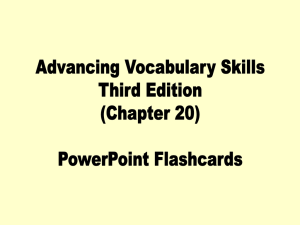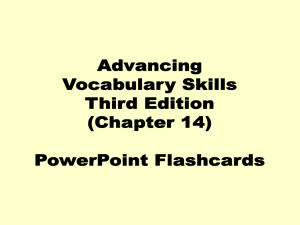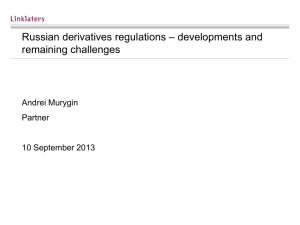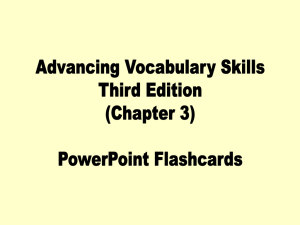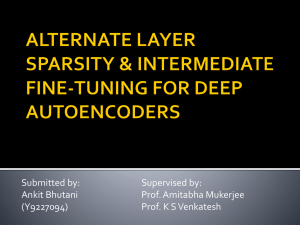the next generation of neural networks
advertisement
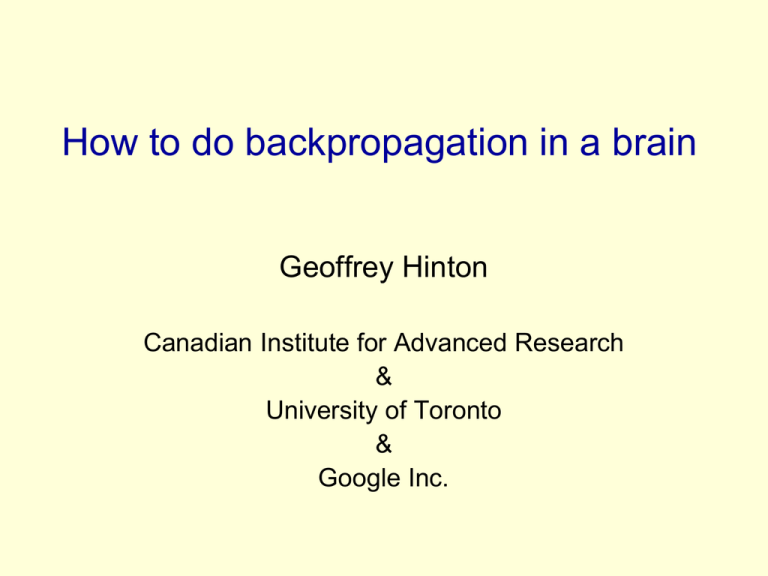
How to do backpropagation in a brain Geoffrey Hinton Canadian Institute for Advanced Research & University of Toronto & Google Inc. Prelude • I will start with three slides explaining a popular type of deep learning. • It is this kind of deep learning that makes back propagation easy to implement. Pre-training a deep network • First train a layer of features that receive input directly from the pixels. – The features are trained to be good at reconstructing the pixels. • Then treat the activations of the trained features as if they were pixels and learn features of features in a second hidden layer. – They are good at reconstructing the activities in the first hidden layer. • Each time we add another layer of features we capture more complex, longer range, regularities in the ensemble of training images. Discriminative fine-tuning • First train multiple hidden layers greedily to be good autoencoders. This is unsupervised learning. • Then connect some classification units to the top layer of features and do back-propagation through all of the layers to fine-tune all of the feature detectors. • On a dataset of handwritten digits called MNIST this worked much better than standard back-propagation and better than Support Vector Machines. (2006) • On a dataset of spoken sentences called TIMIT it beat the state of the art and led to a major shift in the way speech recognition is done. (2009). Why does pre-training followed by fine-tuning work so well? • Greedily learning one layer at a time scales well to really big networks, especially if we have locality in each layer. • We do not start backpropagation until we already have sensible features in each layer. – So the initial gradients are sensible and backpropagation only needs to perform a local search. • Most of the information in the final weights comes from modeling the distribution of input vectors. – The precious information in the labels is only used for the final fine-tuning. It slightly modifies the features. It does not need to discover features. – So we can do very well when most of the training data is unlabelled. But how can the brain back-propagate through a multilayer neural network? • Some very good researchers have postulated inefficient algorithms that use random perturbations. – Do you really believe that evolution could not find an efficient way to adapt a feature so that it is more useful to higher-level features in the same sensory pathway? (have faith!) Three obvious reasons why the brain cannot be doing backpropagation • Cortical neurons do not communicate real-valued activities. – They send spikes. • The neurons need to send two different types of signal – Forward pass: signal = activity = y – Backward pass: signal = dE/dx • Neurons do not have point-wise reciprocal connections with the same weight in both directions. Small data: A good reason for spikes • Synapses are much cheaper than training cases. – We have 10^14 synapses and live for 10^9 seconds. • A good way to throw a lot of parameters at a task is to use big neural nets with strong, zero-mean noise in the activities. – Noise in the activities has the same regularization advantages as averaging big ensembles of models but makes much more efficient use of hardware. • In the small data regime, noise is good so sending random spikes from a Poisson process is better than sending real values. – Poisson noise is special because it is exactly neutral about the sparsity of the codes. – Multiplicative noise penalizes sparse codes . A way to simplify the explanations • Lets ignore the Poisson noise for now. – We are going to pretend that neurons communicate real analog values. • Once we have understood how to do backprop in a brain, we can treat these real analog values as the underlying rates of a Poisson. – We will get the same expected value for the derivatives from the Poisson spikes, but with added noise. – Stochastic gradient descent is very robust to added noise so long as it is not biased. A way to encode error derivatives • Consider a logistic output unit , j, with a cross-entropy error function. -¶E / ¶x j = d j - p j derivative of the error w.r.t. The total input to j target value output probability when driven bottom-up Suppose we start with pure bottom-up output, p j , and then we take a weighted average of the target value and the bottom-up output. We make the weight on the target value grow linearly with time. y j (t) = p j + t d j - t p j A fundamental representational decision: temporal derivatives represent error derivatives • This allows the rate of change of the blended output to represent the error derivative w.r.t. the neuron’s input -¶E / ¶x j = y j error derivative = temporal derivative This allows the same neuron to code both the normal activity and the error derivative (for a limited time). The payoff • In a pre-trained stack of auto-encoders, this way of representing error derivatives makes backpropagation through multiple layers of neurons happen automatically. yj j wij w ji yk k If the auto-encoder is perfect, replacing the bottom-up input to i by the top down input will have no effect on the output of i. wki If we then start moving y j and yk towards their target values, we get: wik dE xi = w ji y j + wki yk = dyi dyi dE yi = ( w ji y j + wki yk ) = dxi dxi The synaptic update rule • First do an upward (forward) pass as usual. • Then do top-down reconstructions at each level. • Then perturb the top-level activities by blending them with the target values so that the rate of change of activity of a top-level unit represents the derivative of the error w.r.t. the total input to that unit. – This will make the activity changes at every level represent error derivatives. • Then update each synapse in proportion to: pre-synaptic activity X rate-of-change of post-synaptic activity If this is what is happening, what should neuroscientists see? weight change relative time of post-synaptic spike 0 • Spike-time-dependent plasticity is just a derivative filter. You need a computational theory to recognize what you discovered! An obvious prediction • For the top-down weights to stay symmetric with the bottom-up weights, their learning rule should be: rate-of-change of pre-synaptic activity X post-synaptic activity A problem (this is where the woffle starts) • This way of performing backpropagation requires symmetric weights – But auto-encoders can still be trained if we first split each symmetric connection into two oppositely directed connections and then we randomly remove many of these directed connections. Functional symmetry • If the representations are highly redundant, the state of a hidden unit can be estimated very well from the states of the other hidden units in the same layer that have similar receptive fields. – So top-down connections from these other correlated units could learn to mimic the effect of the missing top-down part of a symmetric connection. – All we require is functional symmetry on and near the data manifold. But what about the backpropagation required to learn the stack of autoencoders? • One step Contrastive Divergence learning was initially viewed as a poor approximation to running a Markov chain to equilibrium. – The equilibrium statistics are needed for maximum likelihood learning. • But a better view is that its a neat way of doing gradient descent to learn an auto-encoder when the hidden units are stochastic with discrete states. – It uses temporal derivatives as error derivatives. Contrastive divergence learning: A quick way to learn an RBM j vi h j 0 i t=0 data j vi h j 1 i t=1 reconstruction Start with a training vector on the visible units. Update all the hidden units in parallel Update all the visible units in parallel to get a “reconstruction”. Update all the hidden units again. wij ( vi h j vi h j ) 0 1 This is not following the gradient of the log likelihood. But it works well. It is approximately following the gradient of another objective function. One-step CD is just backpropagation learning of an auto-encoder using temporal derivatives v +v W T W h h + h W v true gradient vh hv CD: negligible to first order (to first order) vh ( v v)(h h) vh hv vh THE END




